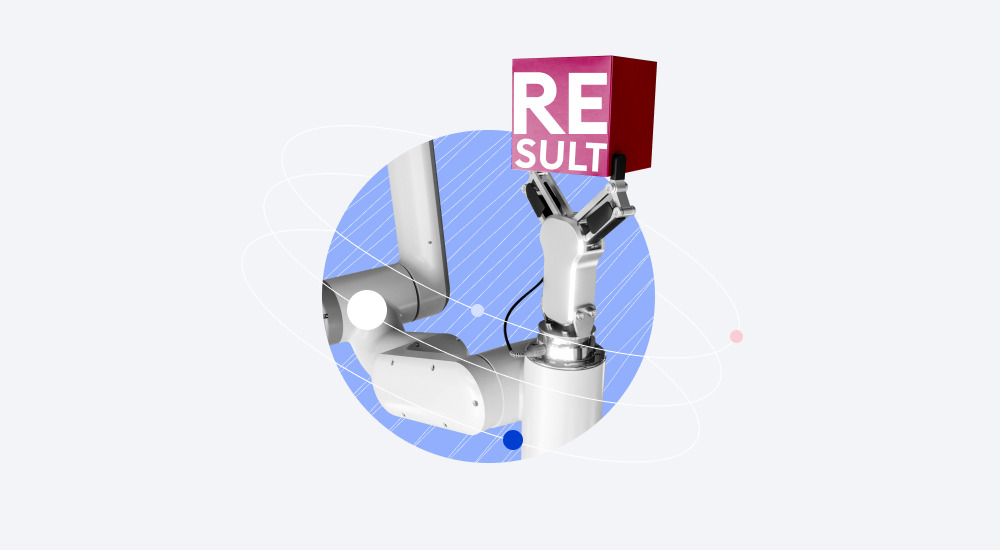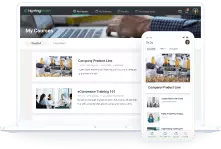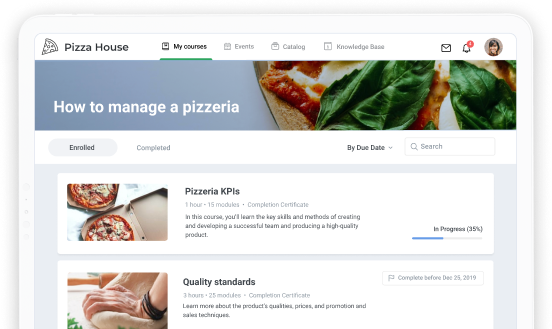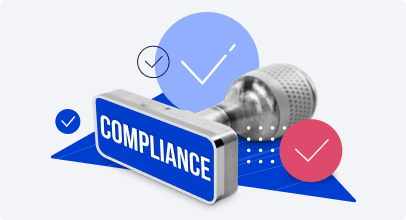How to Build a Manufacturing Training Program that Produces Results

The manufacturing industry moves at breakneck speed. And since every second counts, organizations simply can’t afford to throw money at or devote time to manufacturing training programs that don’t deliver the desired results. This guide explores how to create quality employee training to build a strong industrial workforce and stay ahead in the new world of technology and automation.
You’ll discover everything you need to revolutionize your production line, including:
- What manufacturing training is
- How to create an online manufacturing training program
- How to automate the training process to maximize success
- Common questions related to online manufacturing training
What Are Manufacturing Training Programs?
A manufacturing training program is a type of employee education designed to provide staff with the necessary knowledge and skills to perform their jobs safely and effectively (and adapt to the fast-changing nature of the industry).
Labor shortages and high-risk work environments are common challenges that many manufacturing businesses face, and that’s why training industrial workers is so important. Adequate training programs help employers boost staff engagement and build a more productive and performance-driven workforce. More importantly, proper training can literally be a matter of life and death for employees, so it’s a challenge worth rising to.
While the specific training topics depend on the organization, a basic manufacturing training program typically covers the following areas:
- Safety procedures (spotting, preventing, and reporting risks and hazards in the workplace)
- Lean manufacturing (minimizing waste, the 5S methodology, and how to optimize efficiency)
- Quality control (procedures, inspection techniques, testing methods, and defect analysis)
- Industry-specific technical skills (tools like Six Sigma, etc.)
How to Create an Effective Manufacturing Training Program
While some types of manufacturing training are better suited to on-the-job learning, the fact is that compliance, quality control, and health and safety training can be delivered online. In this section, we reveal how to create quality digital manufacturing training programs that employees actually want to take.
Step 1. Assess training needs
The first thing to be done is to conduct a training needs analysis. This is a comprehensive assessment used to identify what training employees need in order to improve their overall performance. It analyzes the gap between employees’ current skills and those they should have. For example, do employees lack knowledge of a specific manufacturing machine? If so, you’ll need to design a training module covering that topic.
Need help? You can download a free training needs analysis template.
Step 2. Define clear learning goals and objectives
Once you have identified the areas that require training, it’s time to set learning goals and objectives for the training program. Here’s a breakdown of what you need to know.
- How many should I set? Start with one goal per training and then define the learning objectives to help you reach it. As a general rule, aim for around three or four learning objectives per goal. You may need slightly more or less depending on the quantity and complexity of the training topic.
- How should I structure learning goals? Following the SMART framework, your learning objectives should be Specific, Measurable, Achievable, Relevant, and Time-bound.

- How should I communicate goals and expectations? Ensure employees understand the goals and expectations by including them into the description of your online training program and/or at the beginning of each course.
Let’s say you’re delivering a training module on quality control. Here’s an example of the learning objective following the SMART goal-setting technique:
“By the end of Q3, we’ll see a 20% reduction in the assembly line defect rate by providing all quality control staff with targeted training.”
Step 3. Make a training plan
Once you’ve defined your objectives, it’s time to create a training plan. There’s a lot to consider when developing it, especially in a high-stakes area like manufacturing. As such, careful planning is a must. You will also need to enlist the help of in-company subject matter experts (SMEs) to ensure your program is as comprehensive as possible.
While you don’t need to get too bogged down in the details, your training plan should outline all the major elements of the program, including:
- Training delivery methods: Will you deliver your training program online, in person, or through blended learning?
- Learning content types: Will the training include role-plays, multimedia content, lectures, coaching, on-the-job learning, webinars, etc.?
- Evaluation method: How will you track progress and measure the overall success of your program?
Let’s look at a sample training plan:

A sample plan of a manufacturing training program
For a higher-level visual plan, download our free training plan template.
Step 4. Develop training content
The next step is to create your eLearning materials. These include interactive modules, videos, simulations, quizzes, and more. Unless you’re a master coder, the quickest and easiest way to build professional-looking training is with an authoring tool. It allows you to create interactive eLearning resources from scratch or repurpose your existing content and upload it to your LMS as SCORM files.
One of the easiest-to-use but most powerful authoring tools on the market is iSpring Suite. Thanks to its simple PowerPoint design and a rich library of templates, you can create your first manufacturing training module in minutes.
Let’s look at some examples built using iSpring Suite.
Interactions
What: Diagrams, timelines, glossaries, catalogs, FAQs, clickable images, and more
Why: Interactions are excellent for creating microlearning content that motivates learners to interact with the material. This results in more engaged learners and higher knowledge retention rates.
How: Simply choose one of iSpring’s fourteen ready-made templates and customize it by adding your own content.

Bonus tip: Stick to one topic per interaction to avoid information overload.
Quizzes
What: Interactive assessments to engage learners and test their knowledge
Why: Quizzes motivate learners and give L&D teams valuable data on employees’ levels of knowledge.
How: You can make varied and dynamic quizzes in a snap by customizing iSpring’s fourteen ready-made question templates. These include multiple-choice, drag-and-drop, and video questions.
In this example, employees must put their newfound knowledge into practice and identify which product is defective. When they click on the product image, they will receive immediate feedback.

Bonus tip: Avoid trick questions when creating quizzes. Instead, use clear language and only test learners on information that’s covered in the training.
Video lecture
What: A presenter video capture that may include images, infographics, captions, and animations to bring content to life
Why: Videos are an engaging way to simplify complex concepts and appeal to different learning types.
How: Record a video lecture with iSpring Suite, then add some polish and pizazz using its built-in video editor.

Bonus tip: Break longer lectures into segments to avoid overwhelming learners and include regular recaps. This gives them a chance to absorb and reflect on the material.
Slide-based online courses
What: A series of interactive slides with text, images, audio, video, interactions, and quizzes
Why: This simple and intuitive format is perfect for sharing core messages and reinforcing learners’ knowledge in an engaging way.
How: Upload your existing PowerPoint slides to iSpring Suite and convert them into a SCORM course, or build a new online training course from scratch the same way you would build a presentation.

Bonus tip: Steer away from large blocks of text, as this can overwhelm learners. Instead, use bullet points, images, and other visual aids to break up your content.
iSpring Suite
Fully-stocked eLearning authoring toolkit for PowerPoint. No training required to start!
Step 5. Gather feedback
Before you formally launch your manufacturing training program, it’s important to take it for a test drive. Proper testing will ensure you spot any potential issues before the training is out in the wild.
Here’s how to set up a pilot program.
- Identify a pilot group. This group should contain employees of different experience levels and backgrounds; it will give you the most accurate picture of how it performs.
- Hold a quick Q&A session with the pilot group, explaining the goals, expectations, and task at hand.
- Have the testers review the training program several times and note their comments.
- Ask testers to complete a feedback questionnaire.
- Hold a follow-up session to analyze their feedback and clarify doubts.
Remember, you won’t be able to apply all the feedback (or at least not right away), so be realistic and prioritize the key changes. You can add the rest to a list of future improvements.
Here are some sample questions you should include in a feedback questionnaire:
- How useful was the training in helping you understand how to identify, correct, and prevent defects in the assembly line?
- How easy was it to navigate the training content and complete the exercises?
- Was there anything you felt was missing from the training course content?
- Did you find the training engaging?
- How long did it take you to complete the course, and did you think this was reasonable?
- Did the course meet your expectations, and if not, what improvements would you suggest?
- Did you find the training relevant to your daily tasks?
- Would you like to share any additional feedback or comments?
Step 6. Deliver the training
Once you’ve thoroughly tested and tweaked your training program, it’s time to launch it. A learning management system (LMS) is an ideal solution for delivering digital and blended training because it’s flexible, scalable, and trackable.
For example, with iSpring Learn LMS, all you have to do is upload your training content and organize it into personalized learning paths. Then, you can set up who receives the training by creating groups and departments. Learners will get an enrollment notification and can simply follow the link to take the training.
iSpring Learn LMS
Automate corporate training and improve employee performance.
Step 7. Measure training results
Understanding the impact of the training program is essential. And while tracking performance is a major part of this, there are other important metrics to consider as well. When using an LMS like iSpring Learn, you can extract valuable data to track a wide range of learner behaviors. This will offer deep insights into how engaging your training is, its effectiveness, areas in need of improvement, and other important success metrics.

In particular, these three iSpring reports can reveal a lot about your training program:
- Course Completion: See how many learners have completed a specific course. This gives an overview of the engagement level of a particular course or program and is critical for auditing purposes.
- Learner Progress: Visualize the progress of individual learners in a course, including their quiz scores and session times. This is great for spotting knowledge gaps and providing targeted development plans and feedback.
- Quiz Results: Get to know how learners performed on course assessments. This is a good way to measure how effective training content is and where learners need further training or clarification.
How to Automate Manufacturing Training with an LMS
Who wouldn’t want more time in the day to focus on meaningful work and spend less time on menial training management tasks? Automating training with an LMS is an easy way to achieve this.
In this section, we explore just some of the ways you can automate manufacturing training with iSpring Learn LMS and reduce L&D workloads.
Training management tasks
After the initial setup, iSpring runs on its own, making it easy to automate repetitive tasks. For example, rather than manually enrolling learners, scheduling courses, and setting course deadlines, the platform does the hard work for you. Admins simply create rules to enroll employees in specific courses automatically based on their role, location, or other criteria of their choosing.

Communication
You can reduce the time spent communicating with learners by setting up automated reminders and notifications. The messaging feature also allows learners to communicate with instructors directly from the platform, thus streamlining communication channels.
iSpring centralizes all communication under one roof. For instance, the newsfeed feature is great for keeping employees updated on the latest organizational news and events.

iSpring’s interactive organizational chart makes it easy to find the right colleague for a task (this is especially useful for new hires).

Learning tracks
With iSpring Learn, you can build structured learning tracks for different teams and on different training topics. All you have to do is combine the relevant training modules into a single path. You can also set up course prerequisites if modules should be taken in order. These ensure that employees complete specific training materials before they can access others.

Certification and retraining
All industry employers must provide regular compliance training for manufacturing employees. This type of training ensures that workers are up to scratch on the latest industry standards, regulations, and company best practices. With iSpring, you can automate it by setting up retraining. This means employees will be enrolled in the course automatically when it’s time to retake it.
Moreover, admins can set up automated certification. The learning platform will award employees a downloadable certificate of completion when they successfully complete the program (and pass the final assessment). No manual process is required.

LMS reporting
iSpring’s automated LMS reporting allows managers to track learner progress in real time without the need for manual record-keeping. They can schedule weekly reports to arrive right in their inbox and track the metrics that matter.
FAQ
Here, we answer the most common questions about training for manufacturing companies.
What are the benefits of delivering manufacturing skills training online?
There are many advantages of running training online, they include:
- Flexibility: Staff can learn at any time or location, ensuring that shift workers and employees in different time zones can access training.
- Cost-effectiveness: Digital training reduces training costs related to travel, facilities, and instructor fees.
- Consistency: Online manufacturing training standardizes processes and procedures, ensuring every employee receives the same information.
- Engagement: eLearning allows you to incorporate interactive elements, such as videos, simulations, and quizzes, which can boost learner engagement and knowledge retention.
- Accuracy: Digital training is easier to update to reflect changes in the manufacturing process, technology, and industry regulations.
How can organizations keep staff engaged during online manufacturing process training?
Keeping a manufacturing workforce engaged during training is a common challenge, but it’s easy with the right strategies and tools. Here are some best practices to guide you.
- Incorporate diverse content (videos, interactive exercises, quizzes, etc.) to cater to different learner types
- Set clear objectives and expectations and show employees how they align with larger organizational goals
- Offer regular feedback and support throughout the training process
- Leverage gamification elements like badges, points, and leaderboards to motivate your learners
Now, Over to You
From increased productivity to safer working conditions, effective manufacturing training can benefit your business significantly. One of the best ways to automate the training process, reduce costs, and improve the quality of your training is to move it online. All you need is a powerful LMS and a full-featured authoring tool.
If you’re ready to see the benefits of training automation, sign up for a demo of the iSpring Learn LMS and get a 14-day free trial of iSpring Suite today. There’s never been a better time to optimize your manufacturing skills training and build a high-performing workforce.















